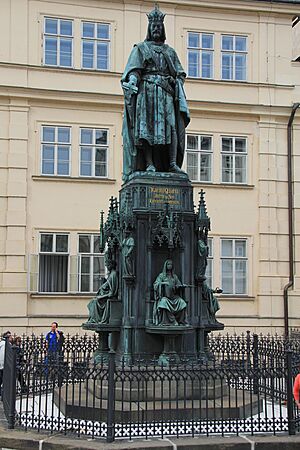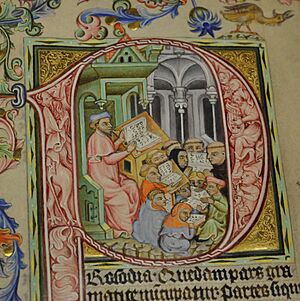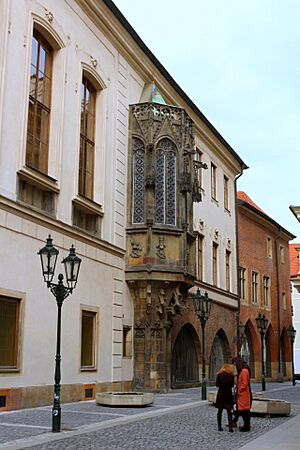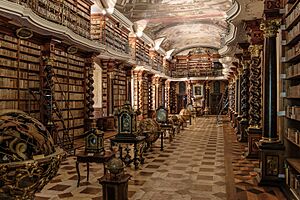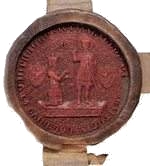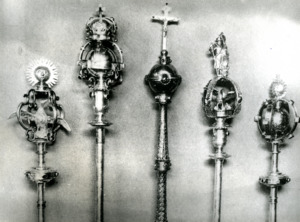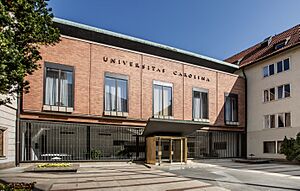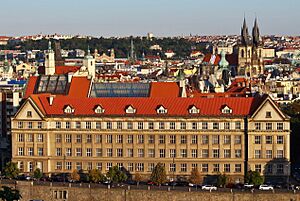Charles University facts for kids
|
Univerzita Karlova
|
|||
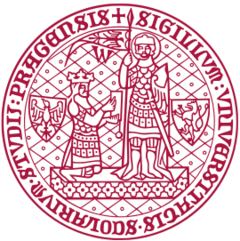 |
|||
| Latin: Universitas Carolina | |||
|
Former name
|
University of Prague (Latin: Universitas Pragensis) | ||
|---|---|---|---|
| Type | Public, ancient | ||
| Established | 26 January 1347 | ||
| Budget | CZK 8.9 billion | ||
| Rector | Milena Králíčková | ||
|
Academic staff
|
4,057 | ||
|
Administrative staff
|
4,026 | ||
| Students | 51,438 | ||
| Undergraduates | 32,520 | ||
| Postgraduates | 9,288 | ||
| 7,428 | |||
| Location |
,
50°05′18″N 14°24′13″E / 50.0884°N 14.4037°E |
||
| Campus | Urban | ||
| Colors |
|
||
| Affiliations | Coimbra Group EUA Europaeum UNICA |
||
Charles University (also known as CUNI) is the biggest university in the Czech Republic. Its full name in Czech is Czech: Univerzita Karlova. It is one of the oldest universities in the world that has been open continuously. It is also the oldest university north of the Alps mountains and east of Paris.
Today, Charles University has 17 different departments, called faculties. These are located in the cities of Prague, Hradec Králové, and Plzeň.
Contents
Discovering the University's Past
How the University Began (1349–1419)
The idea for a university in Prague came from Holy Roman Emperor Charles IV. He asked his friend, Pope Clement VI, to help him start it. On January 26, 1347, the Pope agreed. He issued a special paper to create the university in Prague. It was designed like the famous University of Paris. It would have four main study areas, including theology (the study of religion).
On April 7, 1348, King Charles of Bohemia gave the new university special rights. These rights protected it from local government power. Most Czech history books say the university was founded in 1348.
The university officially opened in 1349. Students were grouped into "nations" based on where they came from. These included Bohemian, Bavarian, Polish, and Saxon groups. The Bohemian group included students from Bohemia, Moravia, and even parts of Hungary. The first student graduated in 1359. The oldest building for lectures was called the Karolinum, built in 1366. In 1372, the Faculty of Law became its own separate university for a while.
In the early 1400s, a scholar named Jan Hus translated some writings of John Wycliffe into Czech. Wycliffe's ideas were very popular. In 1403, the university tried to stop people from following Wycliffe's teachings, but his ideas kept spreading.
During a big disagreement in the church (the Western Schism), the Bohemian "nation" supported King Wenceslaus. The other "nations" supported a different Pope. This meant the vote was 3 to 1 against the Bohemians. But King Wenceslaus changed the rules in 1409. He gave the Bohemian masters three votes, and all other nations combined only one vote. Because of this change, many foreign professors and students, mostly Germans, left Prague. They went on to start the University of Leipzig in May 1409. Before this, the university had many thousands of students. After the change, it lost a large number of them.
In 1409, Jan Hus was chosen as the head of the university. It became a strong center for the Hussite movement. Soon, in 1419, the theology and law departments closed. Only the arts faculty remained.
A Time of Change (1419–1622)
The arts faculty became very important for the Hussite movement. For a while, from 1417 to 1430, no degrees were given out. Sometimes, there were only a few professors. Later, Emperor Ferdinand I invited the Jesuits to Prague. In 1562, they opened their own school called the Clementinum.
From 1618 to 1621, during the start of the Thirty Years' War, the Jesuits were forced to leave. But by 1622, they had a lot of power with the emperor. An order from the emperor on September 19, 1622, gave the Jesuits control over all schools in Bohemia. The remaining professors at the Carolinum left, and the Carolinum building went to the Jesuits.
Charles-Ferdinand University (1622–1882)
A leader named Cardinal Ernst Adalbert of Harrach worked to keep the university separate from other schools. In 1638, Emperor Ferdinand III limited the Jesuits' power. He took back the rights and buildings of the Carolinum. This made the university independent again. During the last years of the Thirty Years' War, students bravely defended the Charles Bridge in Prague.
On February 23, 1654, Emperor Ferdinand III combined the Carolinum and Clementinum. This created one university with four faculties, called Charles-Ferdinand University. The Carolinum at that time only had the arts faculty. The old Carolinum building was rebuilt in 1718.
In the late 1700s, the university started to change. In 1784, German became the main language for teaching instead of Latin. Soon after, Protestants and Jewish people were allowed to study there. The university also saw the need for a Czech language and literature department. Emperor Leopold II created this department in 1791.
In 1848, students fought to have Czech taught more at the university. By 1863, 22 courses were taught in Czech, but most were still in German. In 1864, Germans suggested creating a separate Czech university. Czech professors did not want this, as they wanted to keep the university's long history together.
Splitting into Czech and German Universities
It became clear that neither the German-speaking people nor the Czechs were happy with the university teaching in both languages. The Czechs wanted to keep the university as one but divide it into separate sections for German and Czech speakers. This would allow both groups to share the university's history. However, German speakers wanted two completely separate universities.
After many discussions, Charles-Ferdinand University was split. It became the German Charles-Ferdinand University and the Czech Charles-Ferdinand University. This happened on February 28, 1882. Each part was independent and had equal standing. They shared some facilities like medical and science buildings, the library, and the botanical garden. The German University managed these shared places.
By 1890, the Czech university had 112 teachers and 2,191 students. The German university had 146 teachers and 1,483 students. Both had three faculties. The Theology Faculty was shared until 1891, when it also split.
Before World War I, the German University was home to famous scientists like Albert Einstein. Many important writers like Franz Kafka also studied there.
After the Austro-Hungarian Empire ended in 1918, Czech politicians wanted the university's old symbols to belong only to the Czech university. In 1920, a law was passed that said the Czech university was the true successor to the original university. It was named Charles University. The German university was then officially called the German University in Prague.
In 1932, a new disagreement started over the university's symbols. Tensions grew between the two groups. On November 21, 1934, the German University had to give the symbols to the Czechs. This caused protests and arguments.
Things changed in 1938 when German troops entered parts of Czechoslovakia. On March 15, 1939, the Nazis took control of the Czech lands. The historical symbols were given back to the German University, which was renamed Deutsche Karls-Universität in Prag. On September 1, 1939, it became a "Reichsuniversität" under the German government.
On October 28, 1939, a student named Jan Opletal was shot during a protest. His funeral on November 15, 1939, led to another large protest. On November 17, 1939 (now International Students' Day), the Czech University and all other Czech higher education schools were closed. They stayed closed until the end of World War II. Many students were sent to a concentration camp. On May 8, 1940, the Czech University was officially renamed Czech Charles University.
World War II ended the time when two universities existed in Prague. In 1945, the university's important symbols, like the rector's chain and faculty scepters, were stolen by the Nazis. These historical items have never been found.
Charles University Today (Since 1945)
After 1945, the university started to recover quickly. However, it did not have full academic freedom for long. After the communist government took power in 1948, they removed people who disagreed with their ideas. This continued for many years.
In the late 1980s, things began to get better. Students organized protests, which helped start the Velvet Revolution in 1989. Students and teachers from the university played a big part in this revolution. Václav Havel, a writer and philosopher, became the president of the country in December 1989.
Since January 26, 2022, Professor Milena Králíčková has been the first woman rector (head) of Charles University.
On December 21, 2023, a very sad event happened at the university. A shooting occurred, and 14 people lost their lives, with 25 others injured. The university community was deeply affected by this tragedy.
Where is Charles University Located?
Charles University does not have one big campus. Its different faculties are spread out in Prague, Hradec Králové, Plzeň, and Brandýs nad Labem. Some language centers are in other towns like Dobruška and Poděbrady.
Many university buildings are in different parts of Prague. For example, the Faculty of Arts is in the Old Town. The First Faculty of Medicine is in the New Town.
The oldest building, Karolinum, is in Prague's Old Town. It is the main center of the university. The rector's office is there, and important ceremonies like graduations happen in this building. It was given to the university in 1386 and has been used ever since.
The university also has its own publishing house, Karolinum Press. It runs several museums. The Botanical Garden of Charles University is maintained by the Faculty of Science and is in the New Town.
How Charles University is Organized
University Departments (Faculties)
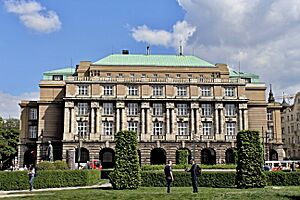
Charles University originally had four main departments: law, medicine, arts (philosophy), and theology. Today, it has 17 faculties. Most are in Prague, with two in Hradec Králové and one in Plzeň.
- Catholic Theological Faculty
- Protestant Theological Faculty
- Hussite Theological Faculty
- Faculty of Law
- First Faculty of Medicine
- Second Faculty of Medicine
- Third Faculty of Medicine
- Faculty of Medicine in Plzeň
- Faculty of Medicine in Hradec Králové
- Faculty of Pharmacy in Hradec Králové
- Faculty of Arts
- Faculty of Science
- Faculty of Mathematics and Physics
- Faculty of Education
- Faculty of Social Sciences
- Faculty of Physical Education and Sport
- Faculty of Humanities
Research Centers
Charles University also has several research centers, such as:
- Institute of the History of Charles University and Archive of Charles University
- Center for Theoretical Study
- Center for Economic Research and Graduate Education (CERGE-EI)
- Environment Center
Other Important Units
- Computer Science Centre
- Centre for Transfer of Knowledge and Technology
- Institute for Language and Preparatory Studies
- Central Library of Charles University
University Rankings
| University rankings | |
|---|---|
| Global – Overall | |
| ARWU World | 301–400 (2023) |
| CWTS World | 197 (2022) |
| QS World | =265 (2026) |
| THE World | 401–500 (2024) |
| USNWR Global | 226 (2023) |
| Regional – Overall | |
| QS Emerging Europe and Central Asia | 2 (2022) |
| National – Overall | |
| ARWU National | 1 |
| QS National | 1 |
| THE National | 1 |
Charles University is highly ranked among universities worldwide. In the QS World University Rankings, it is ranked 1st in Eastern Europe and 265th globally. In 2023, it was ranked among the top 301–400 universities by the Academic Ranking of World Universities.
The university is considered the best in the Czech Republic. It is also one of the best in Central and Eastern Europe.
How Subjects are Ranked
According to the QS Subject Ranking, Charles University is among the top 150 universities in the world for subjects like geography and linguistics.
| QS Subjects | 2011 | 2018 | 2020 | 2023 | 2025 |
|---|---|---|---|---|---|
| Natural Sciences | 174 |
|
|
|
198 |
| Engineering & Technology | 325 |
|
|
|
451-500 |
| Arts & Humanities | 184 |
|
|
|
129 |
| Social Sciences & Management | 229 |
|
|
|
326 |
| Life Sciences & Medicine | 250 |
|
|
|
201 |
| Medicine | 151-200 | 185 |
| Shanghai Subject Fields | 2012 | 2018 |
|---|---|---|
| Mathematics | 151–200 |
|
| Physics | 151–200 |
|
Working with Other Universities
Charles University is a founding member of the 4EU+European University Alliance. This group includes other major universities like the University of Heidelberg and Sorbonne University. It also belongs to the Coimbra Group and the EUA.
The university takes part in the Erasmus Programme. This program allows students to study abroad in other countries. Charles University also has many agreements with universities around the world.
Famous People from Charles University
Notable Alumni
Many famous people have studied at Charles University.
| Before 1882 | Czech University (1882–1939 and 1945–present) |
German University (1882–1945) |
|---|---|---|
|
|
|
Notable Teachers
Many important academics have taught at Charles University.
| Before 1882 | Czech University (1882–1939 and 1945–present) |
German University (1882–1945) |
|---|---|---|
|
|
|
Images for kids
See also
 In Spanish: Universidad Carolina para niños
In Spanish: Universidad Carolina para niños


